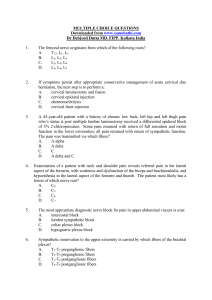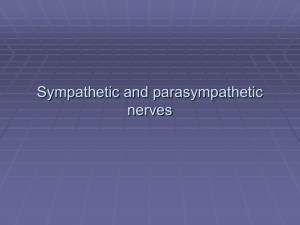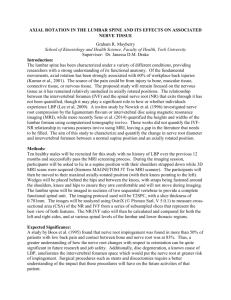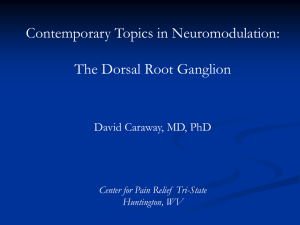100 MCQs on Pain Management with answers
advertisement
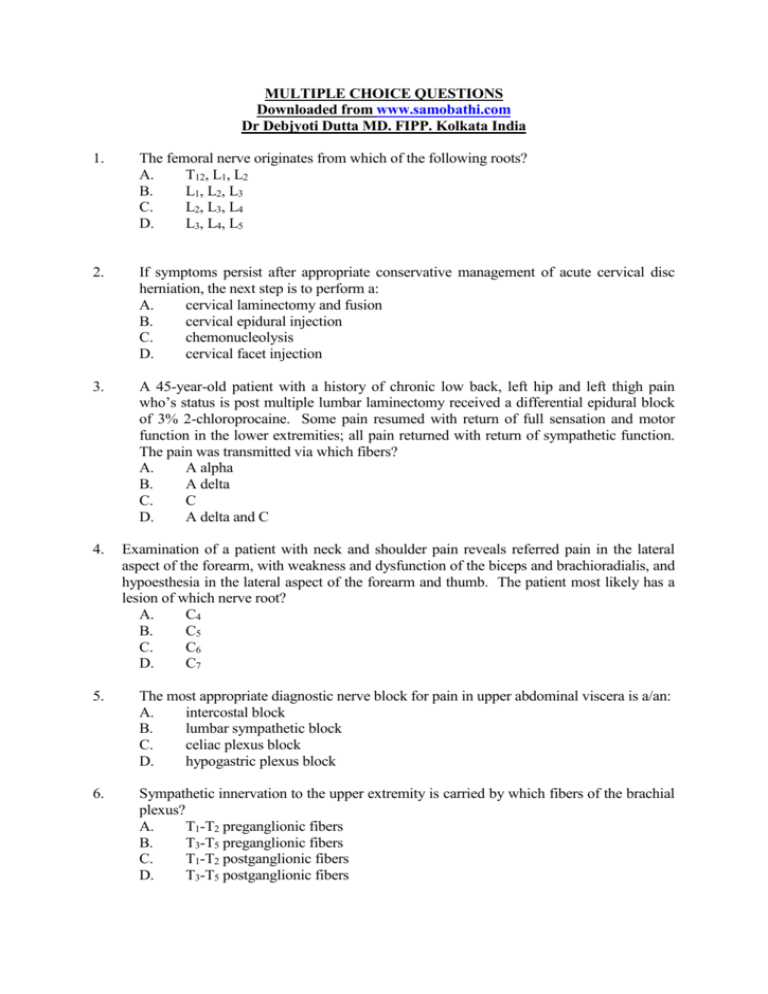
MULTIPLE CHOICE QUESTIONS Downloaded from www.samobathi.com Dr Debjyoti Dutta MD. FIPP. Kolkata India 1. The femoral nerve originates from which of the following roots? A. T12, L1, L2 B. L1, L2, L3 C. L2, L3, L4 D. L3, L4, L5 2. If symptoms persist after appropriate conservative management of acute cervical disc herniation, the next step is to perform a: A. cervical laminectomy and fusion B. cervical epidural injection C. chemonucleolysis D. cervical facet injection 3. A 45-year-old patient with a history of chronic low back, left hip and left thigh pain who’s status is post multiple lumbar laminectomy received a differential epidural block of 3% 2-chloroprocaine. Some pain resumed with return of full sensation and motor function in the lower extremities; all pain returned with return of sympathetic function. The pain was transmitted via which fibers? A. A alpha B. A delta C. C D. A delta and C 4. Examination of a patient with neck and shoulder pain reveals referred pain in the lateral aspect of the forearm, with weakness and dysfunction of the biceps and brachioradialis, and hypoesthesia in the lateral aspect of the forearm and thumb. The patient most likely has a lesion of which nerve root? A. C4 B. C5 C. C6 D. C7 5. The most appropriate diagnostic nerve block for pain in upper abdominal viscera is a/an: A. intercostal block B. lumbar sympathetic block C. celiac plexus block D. hypogastric plexus block 6. Sympathetic innervation to the upper extremity is carried by which fibers of the brachial plexus? A. T1-T2 preganglionic fibers B. T3-T5 preganglionic fibers C. T1-T2 postganglionic fibers D. T3-T5 postganglionic fibers 7. Intense whiteness of fingers with subsequent blue coloration with coldness and red coloration on rewarming is most likely due to: A. frostbite B. Raynaud’s disease C. reflex sympathetic dystrophy D. acute venous thrombosis 8. Indications for lumbar epidural steroid injections include all of the following EXCEPT: A. radicular pain with corresponding sensory change B. radiculopathy due to herniated disc with failed conservative treatment C. acute herpes zoster in the lumbar dermatomes D. postlaminectomy (failed back) syndrome without radiculopathy 9. Which of the following nerve blocks is LEAST helpful in diagnosing sympathetically mediated pelvic pain? A. Differential spinal B. Pudendal nerve C. Superior hypogastric plexus D. Differential epidural 10. Which of the following statements regarding the anatomy of the superior hypogastric plexus is NOT true? A. It lies anterior to L5 vertebra. B. It lies just inferior to the aortic bifurcation. C. It lies right of midline. D. It branches left and right and descends to form the inferior hypogastric plexus. 11. All of the following are indications for a stellate ganglion block EXCEPT? A. reflex sympathetic dystrophy B. acute herpes zoster (ophthalmic division) C. hyperhidrosis D. pancreatitis 12. Which of the following regional anesthesia techniques is NOT commonly used with children due to its side effects? A. Epidural block B. Subarachnoid block C. Caudal block D. Brachial plexus block 13. A brachial plexus block is indicated for all of the following conditions EXCEPT A. sympathetic independent pain due to reflex sympathetic dystrophy B. brachial plexalgia C. angina D. Raynaud's disease 14. A celiac plexus block is effective in reducing pain originating from all of the following organs EXCEPT the: A. pancreas B. transverse portion of the large colon C. gall bladder D. descending portion of the pelvic colon 15. A patient is positioned prone on the fluoroscopic table, the T1-T4 spinous processes are identified on the ipsilateral side, and a skin weal is raised 4-5 cm lateral to the spinous process. A spinal needle is directed to the lamina and "walked" laterally until there is loss of resistance. These procedures are consistent with which type of block? A. Stellate ganglion B. Thoracic sympathetic C. Interpleural D. Thoracic epidural 16. The brachial plexus is formed by which rami? A. C5-T1 anterior primary B. C3-T2 anterior primary C. C5-T1 anterior and posterior D. C3-T2 anterior and posterior 17. Cell bodies of preganglionic fibers of the lumbar sympathetic chain arise at which of the following sites? A. T5-T9 B. T11-L2 C. L3-L5 D. S1-S4 18. A lateral femoral cutaneous block is indicated for which of the following conditions? A. Meralgia paresthetica B. Femoral neuralgia C. Saphenous neuralgia D. Groin pain 19. Which of the following statements is true regarding neurolytic concentrations of less than 2% phenol? A. They have no effect. B. They selectively destroy A-delta and C fibers. C. They have a reversible local anesthetic action when applied to nerve bundles. D. They destroy nerves but have no effect on blood vessels. 20. Mydriasis, tachypnea, tachycardia, delirium and a modest decrease in pain can be produced by agonists of which receptor type? A. Mu B. Kappa C. Delta D. Sigma 21. A diminished triceps jerk indicates a lesion of which nerve root? A. B. C. D. C4 C5 C6 C7 22. To achieve sympathetic denervation of the head and neck, the best site of blocking is the: A. middle cervical ganglion B. superior cervical ganglion C. stellate ganglion D. sphenopalatine ganglion 23. The lesser splanchnic nerve is formed by which of the following sympathetic nerves? A. T5-T7 B. T8-T9 C. T10-T11 D. T12 24. Continuous radiofrequency (CRF) procedures for pain: A. B. C. D. 25. Use alternating current with a frequency of 500 Hz. Produce an effect by coagulating target nerves. Produce heat energy in tissue distal to the active tip of the electrode. Produce differential lesioning of target nerves. Pulsed radiofrequency (PRF) procedures for pain: A. Use a 50 kHz alternating current delivered in 20 ms pulses at a frequency of 2 Hz for 120 s. B. Cause significant heating of target tissue. C. Lead to heat dissipation by convection, conduction and radiation. D. Have a mechanism of effect that is not clear. 26. In chronic pain management: A. Percutaneous radiofrequency trigeminal rhizotomy is a first line treatment for trigeminal neuralgia. B. Potential side-effects of trigeminal rhizotomy include diplopia. C. Selection criteria for radiofrequency neurotomy in somatic spinal pain include placebo-controlled diagnostic blocks. D. Radiofrequency neurotomy of the dorsal ramus of C3 is used in management of cervicogenic headache. 27. A fifty year old senior administrator who presents with Right sided earache of one month’s duration. The pain radiates into the temple area and down the side of her face. The pain is worst when she wakes in the morning and after eating.On examination the ear is clear, there is lateral deviation of the jaw on opening and all other observations are normal.The MOST likely diagnosis is: A. Temporal arteritis B. Trigeminal neuralgia C. Temporo mandibular joint dysfunction D. Eustachian Tube Dysfunction 28. "Allodynia" is: A. Pain caused by stimuli that are usually not painful B. The 'burning' sensation of causalgia C. Red flare with nerve damage D. Due to reflex sympathetic dystrophy 29. The pain of chronic herpetic neuralgia is usually controlled by A. ipsilateral stellate ganglionectomy B. intrathecal alcohol injection C. Anti-convulsants D. dorsal rhizotomy 30. Neurolytic lumbar sympathetic block: Confirm needle placement by: A. Injection local anaesthetic to check effect just prior to alcohol injection B. Nerve stimulator C. Injection gives sensation of warmth in affected area D. Use an image intensifier 31. Coeliac plexus block A . Is used to treat visceral pain of malignant origin. B. Requires 22g Radiofrquency needle. C. Causes hypertension. D. Cannot be used in pain of non malignant cause. 32. A coeliac plexus block with alcohol may cause: A. Abdominal pain B. Diarrhoea C. Pleuritic chest pain D. Groin pain 33. A 60-year-old diabetic has had a below knee amputation for an ischaemic leg. He has neuropathic pain being managed with oxycodone 40 mg bd and paracetamol 1 g qid. He is also on omeprazole 20 mg daily for reflux. You decide to commence gabapentin. Before deciding on a dosage regimen and commencing therapy it is most important that you A. cease his omeprazole B. check his hepatic transaminase level C. check his renal function D. check his QT interval on a resting EGG 34. Complex Regional Pain Syndrome A. Characterized by disabling pain, swelling, vasomotor instability, sudomotor abnormality, and impairment of motor function B. Type II CRPS was formally known as reflex sympathetic dystrophy C. To be managed with sympathetic blocks only. D. Physiotherapy has no role. 35. A strategy shown to reduce the incidence of severe phantom limb pain is the use of A. continuous regional blockade using nerve sheath catheters B. patient controlled analgesia with opioids post-op C. perioperative ketamine D. perioperative NSAIDs 36. Regarding Epidural Abcess - which is WRONG A. Diagnosis is DEPENDENT on triad of back pain, fever, and paralysis B. Occurs at a rate of 1:1000-3000 (OR 1:2000 - 1:5000) C. Worse outcomes if advanced age D. Usually gram positive cocci 37. Sympathetic blocks are used in the following conditions:except A. B. C. D. Reynaud’s syndrome. Herpes zoster. Chronic pancreatitis. Migraine. 38. Clinical features of fibromyalgia include all except A. Localized pain. B. Fatigue. C. Sleep disturbance. D. Diarrhoea. 39. Regarding management of fibromyalgia: A. B. C. D. Educating the patient regarding the condition plays an important role. Tri-cyclic agents are not beneficial in treating pain. There is evidence that strong opioids are beneficial. There is evidence that steroids are beneficial. 40. Indications for spinal cord stimulation include: all except A. B. C. D. Complex regional pain syndrome. Failed back surgery syndrome. Post-amputation pain. Postoperative pain. 41. Which of the following statements regarding management of neck pain in WAD injuries is TRUE? A. B. C. D. Evidence supports benefit of using cervical collar. Early RF neurotomy of cervical facet neurotomy gives better outcome. There is enough evidence to support passive mobilization of C/S as a single treatment Interventions of benefit include home exercise, analgesics , combined with specific exercises. 42. A 42-year-old Caucasian male presented with a 10-week history of left leg and back pain. He described his pain as sharp and shooting down to posterior left thigh and calf, and posterior ankle. Straight leg raise test is positive on left side, and trigger points are present over L QL muscle. Weight-bearing lumbar radiographs demonstrate mild loss of disc height at L5-S1, and MR images demonstrate a large left paracentral disc herniation at L5S1 with moderate degenerative changes at L4-L5. Sharp and shooting pain in posterior left thigh/calf and posterior ankle is: A. B. C. D. Due to degenerative changes of L L4-L5 facet joint Referred pain due to irritation of Right S1 nerve root Due to irritation of the Left S1 nerve root caused by L5-S1disc herniation Radicular pain originating from L QL trigger points 43. Which of the following statements about electrical potentials detected in trigger points is FALSE? A. They are not restricted to trigger points B. They represent miniature endplate potentials C. They represent activity in intramuscular nerves or from sympathetic nerves in the muscle D. They are evidence of pathology by trigger points 44. Which of the following statements about low back pain is incorrect? A. Nearly 80% of acute low back pain cases are self-limiting. B. Yellow flags predict poor recovery and a high risk of progression from acute to chronic LBP. C. Straight leg raising test has a high sensitivity for sciatica. D. Routine MRI is advised for patients who can afford it. 45. A 63-year-old woman presents with low back pain and cramping in both posterior thighs and numbness radiating into the feet with ambulation. It worsens with standing and walking and improves with sitting and bending forward. She has no bowel or bladder complaints. On examination, she has full strength, normal sensation, reflexes are symmetric and she has 2+ peripheral pulses. Straight leg raise is negative. What is this patient’s most likely diagnosis? A. B. C. D. Cauda equina syndrome Internal disc disruption Spinal stenosis Vascular claudication 46. A 33-year-old man presents with a sudden onset of back and left leg pain and weakness after performing heavy squats at the gym. Radiographs are normal, but a MRI reveals a posterolateral left L5-S1herniated disc. What would a careful neurologic examination likely reveal? A. Foot plantar flexion weakness with absent Achilles reflex B. Foot plantar flexion weakness with absent patella reflex C. Great toe extension weakness with absent Achilles reflex D. Great toe extension weakness with absent patella reflex 47. Botox is indicated in A. B. C. D. Episodic migraine Chronic migraine Hemiplegic migraine Basilar type migraine 48. The secetomotor fibre to the parotid gland passes through A. B. C. D. Otic ganglion Sphenopalatine ganglion Geniculate ganglion Lesser ganglion 49. The vertebral artery traverses all of the following except? A. Foramen magnum B. Subarachnoid space C. Intervertebral foramen D. Foramen transversarium 50. Red flag markers for serious spinal pathology include: A. B. C. D. 51. History of previous spinal trauma. Pain persisting for >1 yr. History of steroid use. History of depression. A. B. C. D. DRG is widest at L1 L3 S1 S3 A. B. C. D. Most commonly missed nerve with interscalene approach to brachial plexus: Ulnar Median Musculocutaneous Radial A. B. C. D. Artery of Adamkiewicz arises at following spinal level T1-t6 T5-t8 T9-l-2 T11-l3 A. B. C. D. Approach to celiac plexus are all except Intercrural Lateral Transcrural Retrocrural A. B. C. D. Potential complications of stellate ganglion block all except Pneumothorax Lesion of recurrent laryngeal nerve Neuritis Horners syndrome A. B. C. D. Gasserian ganglion Mandibular br is located medial to ophthalmic Lies outside cranium in meckel cave Foramen rotundum is used for blockade Medial br are sensory and lat br is partial motor 52. 53. 54. 55. 56. 57. Blood supply to spinal cord A. 2 post spinal and 2 ant spinal art B. 1 post and 1 ant C. 2 post and one ant D. Branches of lumbar arteries 58. Nutrition to lumbar intervertebral disc is from A. Posterior spinal artery B. Anterior spinal artery C. Internal iliac artery D. Lumbar artery 59. Trigeminal ganglion: which is correct A. Located in anterior cranial fossa B. Ophthalmic branch is located ventrally C. Maxillary branch is a mixed nerve with sensory and motor component D. TG links with automatic nerves system through ciliary, sphenophalatine, otic and sub maxillary ganglia 60. 50 year old man with no comorbid illness is given (left) maxillary nerve block by extra oral approach. All can occur as except: A. Blindness of (left) eye B. Air can be aspirated if needle is not in proper place C. Paraesthesia while the needle hits lateral pterygoid lamina D. Corneal anesthesia 61. Mandibular nerve supplies motor nerve to all except: A. Tensor tympani B. Buccinator C. Mylohyoid muscle and anterior belly of digastric muscle D. Muscle of mastication 62. All of the following are true about glossopharyngeal nerve block except: A. Styloid process in as important landmark B. Used to differentiate geniculate ganglion neuralgia C. Used in awake intubation D. Useful in significant behavioral abnormalities and atypical facial pain. 63. Identify the structure A. Uncovertebral joint B. Facet joint C. Atlanto-Axial Joint D. Atlanto- occipital joint 64. Needle is passed through A. B. C. D. 65. Greater palatine foramen Maxilary Sinus Foramen ovale Infra temporal fossa The procedure shown in the picture is indicated in all of the following conditions except A. B. C. D. Chronic Pelvic pain CRPS Herpes Zoster involving the lower extremities Pulmonary Thromboembolism 66. A 59 year-old female complaining of moderately severe low back pain and right buttock pain which is exacerbated with prolonged sitting. On physical examination there is sciatic notch tenderness and the pain is exacerbated with flexion, adduction, and internal rotation of the right hip. Which of the following is the most likely diagnosis? (A) L5-S1 facet syndrome (B) Piriformis syndrome (C) Sacroiliac (SI) joint syndrome (D) L3 radiculopathy 67. Following are the complications of percutaneous RF procedure in trigeminal neuralgia except – A. B. C. D. Keratitis Paralysis of the buccinator muscle Temporary paralysis of the third and fourth cranial nerves Anaesthesia dolorosa 68. Stellate ganglion is located between the A. C6-C7 B. C7-T1 C. C5-C7 D. C5-C6 69. In relation to the stellate ganglion the subclavian artery is located A. anteriorly B. posteriorly C. laterally D. medially 70. Despite satisfactory stellate ganglion block for sympathetic-mediated pain, the pain relief in upper extremity is inadequate. The technical explanation for this may lie in inadequate spread of local anesthetics to A. B. C. D. C5 nerve root inferior cervical ganglion first thoracic ganglion T2 and T3 gray communicating rami 71. When performing lumbar discography, the “opening pressure” is the recorded pressure Signifying A. first appearance of the contrast in nucleus pulposus B. opening of the annular tear to the contrast C. reproduction of concordant pain D. resting pressure transduced from thenucleus 72. Intradiscal electrothermal coagulation (IDET) outcomes were adversely affected by A. B. C. D. appearance of the disc on T2-weighted MRI images obesity age coexisting radicular pain 73. When performing lumbar discography, in relation to the laterality of pain, which of the following should be the needle entry site? A. Ipsilateral B. Contralateral C. Laterality does not make a difference D. Guided by MRI images 74. Apatient with painful sacroiliac joint syndrome had only short-term relief with two sacroiliac (SI) injections using local anesthetics and steroids. Which of the following is the next treatment option? A. B. C. D. SI joint fusion S1, S2, S3, S4 radiofrequency Denervation L5, S1, S2, S3 radiofrequency denervation L4, L5, S1, S2, S3 radiofrequency denervation 75. Radiation dose to the patients and medical personnel can be reduced by A. decreasing the distance between the image intensifier and the patient B. increasing the distance between the image intensifier and the patient C. using continuous fluoroscopy D. oblique views 76. Personnel radiation protection can be achieved by A. lead aprons B. lead glasses C. increased distance from the x-ray D. all of the above 77. T2 and T3 sympathetic block A. B. C. D. is used for treatment of upper extremity complex regional pain syndrome (CRPS) will help by denervating the Kuntz nerves can lead to pneumothorax should avoid radiofrequency of T2 and T3 sympathetic ganglia 78. Vertebroplasty may be indicated for A. multiple myeloma B. chronic compression fractures of vertebral body C. osteolytic metastatic tumors D. facet arthropathy 79. Complications from vertebroplasty include all except A. B. C. D. Pulmonary embolus Intradiscal leak of polymethyl methacrylate Hemiplegia Psoas muscle leak of polymethyl methacrylate and femoral neuropathy 80. Which of the following is incorrect with regards to piriformis muscle injection? A. B. C. D. Should be done at lateral part of a muscle Botox can be used Nerve stimulation may aid in muscle location Identification of the muscle can be done through rectal examination 81. SI joint pain A. B. C. D. Is transmitted by the S1-S4 levels of spinal nerves Has been treated by the SI joint fusion Can be relieved by blind steroid injections Is transmitted by L4 medial branch, L5 dorsal ramus, and S1-3 lateral branches 82. Ganglion impar block A. B. C. D. Is indicated for testicular pain. Trans-sacrococcygeal approach is a safer way. Is best performed by anococcygeal approach. Can be complicated by perforation of appendix. 83. Visual analogue scale (VAS) all are true except A. B. C. D. Correlate highly with pain measured on verbal and numerical rating scales Is minimally intrusive Assumes that pain is a multidemnsional experience Measures the intensity of pain 84. McGill Pain Questionnaire A. B. C. D. Consists of three major measures Was developed by mcgill Is not widely used Is a single-dimensional pain scale 85. Which of the following conditions is more likely to be associated with neuropathic pain? A. B. C. D. E. Traumatic nerve injury Stroke Syringomyelia Multiple sclerosis 86. The least common adverse effects associated with TCA are (is) A. B. C. D. Dry mouth Seizure Urinary retention Blurred vision 87. Compared to TCAs, SSRIs A. B. C. D. Are more effective in the treatment of pain Have more side effects Have less side effects Have more serious consequence of overdosage 88. Which of the following is false regarding tramadol? A. B. C. D. It has opioid characteristics There is a dose limit of 400 mg/d It is a centrally acting analgesic No effect on norepinepherine or serotonin 89. The benzodiazepine which is used to treat various neuropathic pain syndromes is A. B. C. D. Diazepam Clonazepam Flunazepam Lorazepam 90. Which of the following are not the risk associated with SCS? A. B. C. D. Epidural hematoma Spinal cord injury Catheter Breakage Electromechanical failure of lead or extension cable 91. Which of the following is (are) true regarding SCS for visceral pain? A. SCS suppresses visceral response to colon distention in animal models B. SCS is a first-line treatment for visceral pain C. Case studies have indicated SCS may be helpful for visceral pain but at this time there is a lack of supporting randomized controlled trials D. A good lead placement for stimulation of chronic pancreatitis would logically be around T12 or L1 92. Which of the following should be considered when selecting patients for SCS? A. Disease states B. Untreated drug addiction C. Patient comorbidities D. Physician’s monthly case quota 93. Which of the following is (are) true regarding the history of electrical stimulation for the treatment of pain? A. Electrical stimulation for the treatment of pain dates back to the first century AD when electrical fish were documented to be used in the treatment of gout B. Implantable SCS were used for treatment of pain for a decade prior to the published gate control theory of pain C. Early stimulation case reports were of peripheral nerve stimulation; later emphasis turned toward SCS D. Psychiatric and/or psychologic screening evaluation prior to implants was a new idea imposed upon physicians by health maintenance organizations in the 1990s 94. Needle shown in the picture is positioned for A. B. C. D. Spinal Cord Stimulation Vertebroplasty Cervical Facet Median Branch Block Hypogastric plexus block. 95. Identify the nerve root A. B. C. D. L4 L5 S1 S2 96. Identify the procedure A. B. C. D. Lumbar Interlaminar epidural Lumbar transforaminal epidural Caudal epidural Lumbar sympathetic block 97. Identify the complication A. B. C. D. Intravenous uptake Intraarterial uptake Intrathecal uptake Epidural spread 98. Positive lumbar Discogram for Mechanical disc sensitization is A. B. C. D. <30 psi >30 psi <50 psi <90psi 99. Ramsay Hunt syndrome is caused by infection of varicella-zoster virus of A. Sphenopalatine ganglion B. Gasserian ganglion C. Geniculate ganglion D. Glossopharyngeal ganglion 100. In all chronic pain there are problems in the nervous system except A. CRPS B. Fibromyalgia C. Migraine D. Rheumatoid arthritis ANSWERS 1. Correct answer is C 2. Correct answer is B 3. Correct answer is D 4. Correct answer is C 5. Correct answer is C 6. Correct answer is A 7. Correct answer is A 8. Correct answer is D 9. Correct answer is B 10. Correct answer is C 11. Correct answer is D 12. Correct answer is B 13. Correct answer is C 14. Correct answer is D 15. Correct answer is B 16. Correct answer is A 17. Correct answer is B 18. Correct answer is A 19. Correct answer is C 20. Correct answer is D 21. Correct answer is D 22. Correct answer is C 23. Correct answer is C 24. Correct answer is B 25. Correct answer is D 26. Correct answer is D 27. Correct answer is C 28. Correct answer is A 29. Correct answer is C 30. Correct answer is D 31. Correct answer is A 32. Correct answer is B 33. Correct answer is C 34. Correct answer is A 35. Correct answer is C 36. Correct answer is A 37. Correct answer is D 38. Correct answer is D 39. Correct answer is A 40. Correct answer is D 41. Correct answer is D 42. Correct answer is C 43. Correct answer is D 44. Correct answer is D 45. Correct answer is C 46. Correct answer is A 47. Correct answer is B 48. Correct answer is B 49. Correct answer is C 50. Correct answer is A 51. Correct answer is C 52. Correct answer is A 53. Correct answer is C 54. Correct answer is B 55. Correct answer is D 56. Correct answer is D 57. Correct answer is B 58. Correct answer is D 59. Correct answer is D 60. Correct answer is D 61. Correct answer is B 62. Correct answer is D 63. Correct answer is A 64. Correct answer is D 65. Correct answer is D 66. Correct answer is B 67. Correct answer is B 68. Correct answer is B 69. Correct answer is A 70. Correct answer is D 71. Correct answer is A 72. Correct answer is B 73. Correct answer is C 74. Correct answer is D 75. Correct answer is A 76. Correct answer is D 77. Correct answer is A 78. Correct answer is A 79. Correct answer is C 80. Correct answer is A 81. Correct answer is D 82. Correct answer is B 83. Correct answer is C 84. Correct answer is A 85. Correct answer is C 86. Correct answer is B 87. Correct answer is C 88. Correct answer is D 89. Correct answer is B 90. Correct answer is C 91. Correct answer is B 92. Correct answer is A 93. Correct answer is B 94. Correct answer is B 95. Correct answer is B 96. Correct answer is A 97. Correct answer is A 98. Correct answer is C 99. Correct answer is C 100. Correct answer is D

